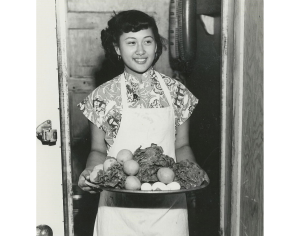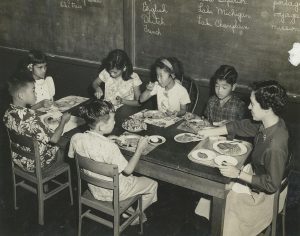The Hawaii Department of Education’s School Food Services Branch (SFSB) has been feeding Hawaii’s keiki (children) for more than 70 years. In 2015, then-Lieutenant Governor Shan Tsutsui convened the Hawaii Farm to School Advisory Group to develop a pathway for including local food in school meals in Hawaii.
Today, ‘Aina Pono is SFSB’s commitment to promoting student health, protecting the environment, and advancing farm to school by purchasing fresh and local foods, greening school cafeterias, reducing waste, and supporting school gardens and nutrition, agriculture, health and food education.
‘Aina Pono is an expression of collective pride in food grown in the islands, the ingenuity of the people trusted to feed Hawaii’s keiki, and the collective strength to return our communities to a legacy of cultivating fresh, locally grown sustenance to build the minds of tomorrow.
Quick Navigation
Click any of the links below to navigate to and view school year sections.

School Year 2014-2015
Hawai‘i Farm to School Advisory Group
- Lieutenant Governor Shan Tsutsui forms a farm to school advisory group and consults the Governor, chair of the Hawai‘i Department of Agriculture and local food systems leaders to explore state-level initiatives to increase local food procurement by HIDOE, as well as supporting legislation to create a state-level farm to school program.
School Year 2015-2016
Farm to School Leadership by Lieutenant Governor Shan Tsutsui
- On July 7, 2015, Governor David Ige signs Senate Bill 376 into law as Act 218, formally establishing a state-level farm to school program, and appoints Lieutenant Governor Tsutsui to spearhead the initiative.
- Lieutenant Governor Tsutsui expands the Hawai‘i Farm to School Advisory Group to include non-governmental leaders in the farm to school field to develop a comprehensive pathway for institutional purchasing of local food by SFSB with the goal of increasing local food production and food security statewide.
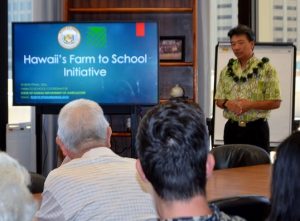
School Year 2016-2017
Kohala Pilot
- Acting Governor Tsutsui proclaims October Farm to School Month in Hawai‘i.
- The Office of the Lieutenant Governor and SFSB partner with the Hawai‘i Department of Agriculture, State Procurement Office and The Kohala Center to launch the state’s first Farm to School Cafeteria Pilot Project at the Kohala Complex on Hawai‘i Island.
- The project team chooses Kohala as the pilot site thanks to Kohala Elementary School Principal Danny P. Garcia’s longstanding commitment to farm to school. Beyond Green Sustainable Food Partners leads pilot implementation at the Kohala High School cafeteria, which also serves Kohala Elementary School and Kohala Middle School (combined enrollment of approximately 780 students). The Kohala cafeteria team led by Priscilla Galan works incredibly hard to prepare new student-approved, scratch-cooked meals featuring local foods.
- The results exceed expectations—the cafeteria doubles the purchasing of local food from 20 to 42.5 percent; triples the purchasing of fresh food from 27 to 82 percent, costs decrease by tens of thousands of dollars, school lunch participation increases by 5 percent (although breakfast participation remains unchanged), overproduction decreases by 10 percent; surveys indicate that a majority of students enjoy the new meals, and cafeteria staff develop new skills to scratch-cook meals and reduce waste.
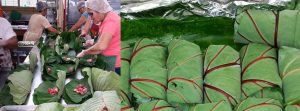
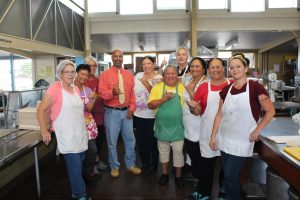

School Year 2017-2018
Unveiling the ‘Aina Pono Logo
- ‘Aina Pono’s Executive Committee consults with Native Hawaiian leader and public relations executive Adrian Kamali‘i of The Island Agency NYC+HNL and Blackletter Group CEO Bobby Senaha to name the program and create an official logo.
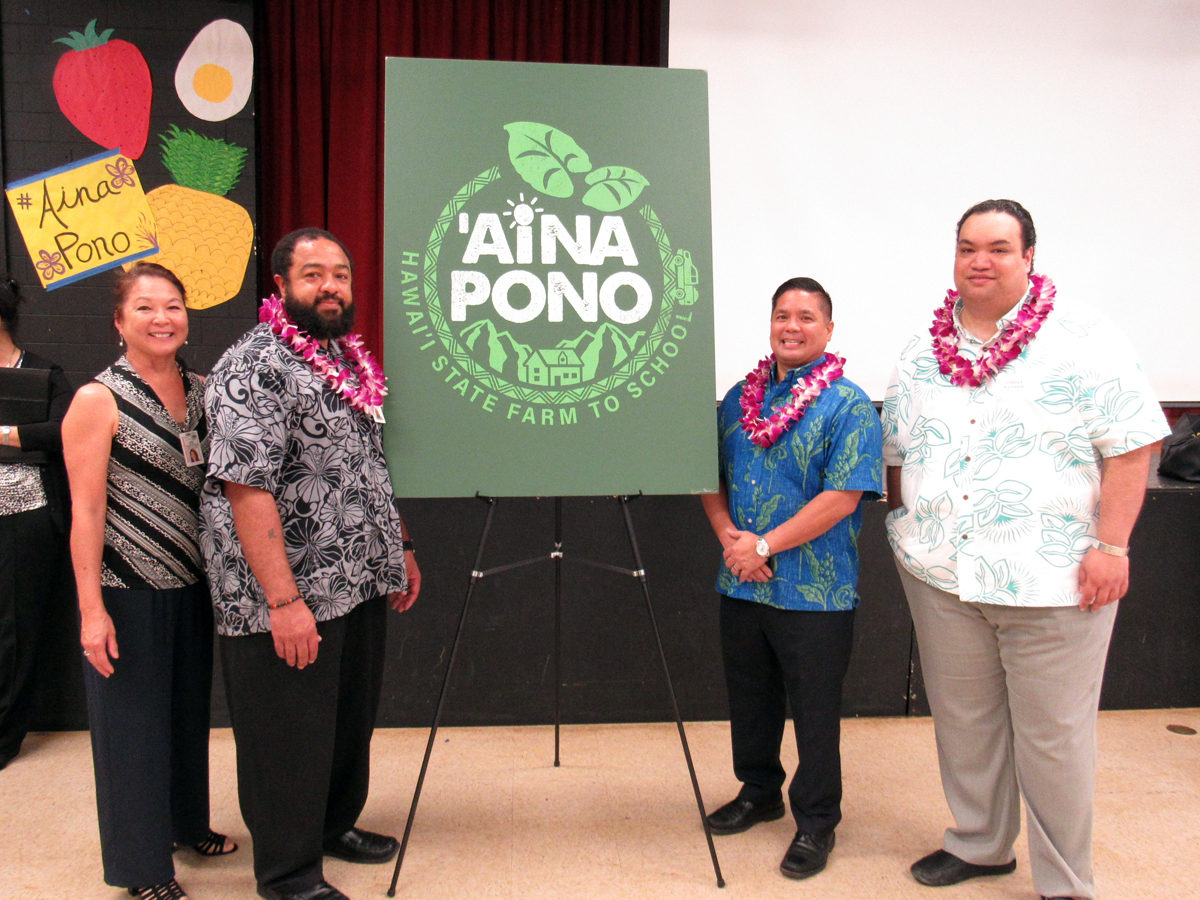
Farm to School Leadership by Lieutenant Governor Doug Chin
- Hawai‘i Attorney General Douglas S. Chin becomes Lieutenant Governor and assumes leadership of ‘Aina Pono.

‘Aina Pono Harvest (formerly known as ‘Aina Pono: Harvest of the Month)
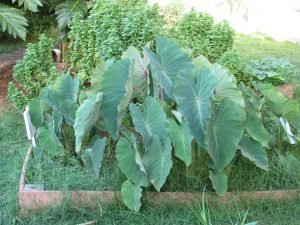 School Food Services Branch launches its ‘Aina Pono Harvest program, through which students at all 256 schools statewide are offered one meal per month featuring a local food item, to:
School Food Services Branch launches its ‘Aina Pono Harvest program, through which students at all 256 schools statewide are offered one meal per month featuring a local food item, to:
- Systematically increase local purchasing across all 256 schools
- Meet the local agricultural industry where they currently are with hopes of growing the industry to meet SFSB’s complete needs over time.
- Introduce cafeteria workers to new recipes
- Introduce students to a variety of local items, especially indigenous Hawaiian foods such as ‘ulu (breadfruit) and kalo (taro).
- ‘Aina Pono Harvest meals highlight the following local crops:
- Beef – December 2017: Paniolo Patty (~18,000 pounds)
- Banana – January 2018: Banana Crumble (~20,000 pounds)
- Papaya – February 2018: Papaya Bread (~18,000 pounds)
- Pineapple – March 2018: Sweet & Sour Pork (~12,000 pounds)
- ‘Ulu (Breadfruit) – March/April 2018: ‘Ulu & Kalua Pork Wrap (~2,600 pounds)

- The ‘Aina Pono Harvest program is featured in several online/print publications and television. Live demonstrations air on the local morning news broadcasts.
- ‘Aina Pono Harvest recipes are adapted for home use and shared with the community so families can recreate these delicious dishes year-round.

Mililani Pilot
- The Executive Committee chooses Mililani High School as the site for the second Farm to School Cafeteria Pilot Project. The school is located near several local farms, which help to make it an ideal candidate to test the large-scale implementation of the Farm to School program.
- Mililani High School is HIDOE’s second largest food production site, serving approximately a total of 2,500 lunches per day to students at Mililani High School, Mililani Uka Elementary and Mililani Waena Elementary.
- Thanks to Principal Fred Murphy’s commitment and vision, the receptivity and hard work of the cafeteria team led by manager Debora Kam, the student body’s enthusiasm, the training provided by Beyond Green Sustainable Food Partners and continued support from the administrators at Mililani High School, Mililani Uka Elementary, and Mililani Waena Elementary, the program is successful.
- Local food procurement triples from 3 to 15 percent. Fresh food increases from 16 to 50 percent. Overproduction decreases by 20 percent. Costs decrease by roughly $108,000. High school lunch participation increases from 14.2 to 22.4 percent, with the actual number of meal purchases increasing by 56.6 percent from 31,467 to 50,853. Lunch participation at Mililani Uka increases by 10 percent but decreases by 9 percent at Mililani Waena.
- A Student Farm to School Advisory Group is created and includes student senators from the Associated Students of Mililani High School (ASMHS).
- Student voice plays an important role in the pilot program and the menu development process. Students actively provide their feedback through taste-testing sessions, surveys, and events with HIDOE leadership, government officials, and school administration and staff.
- The student-led food revolution to “eat local” and reduce the amount of food students waste includes sharing key messages through various platforms, including television and radio broadcasts, posters, newsletters and online petitions. Students meet with Hawaii State legislators to seek funding and legislation to continue and grow the ‘Aina Pono program so fresh, scratch-cooked meals can be served to more public school students statewide.
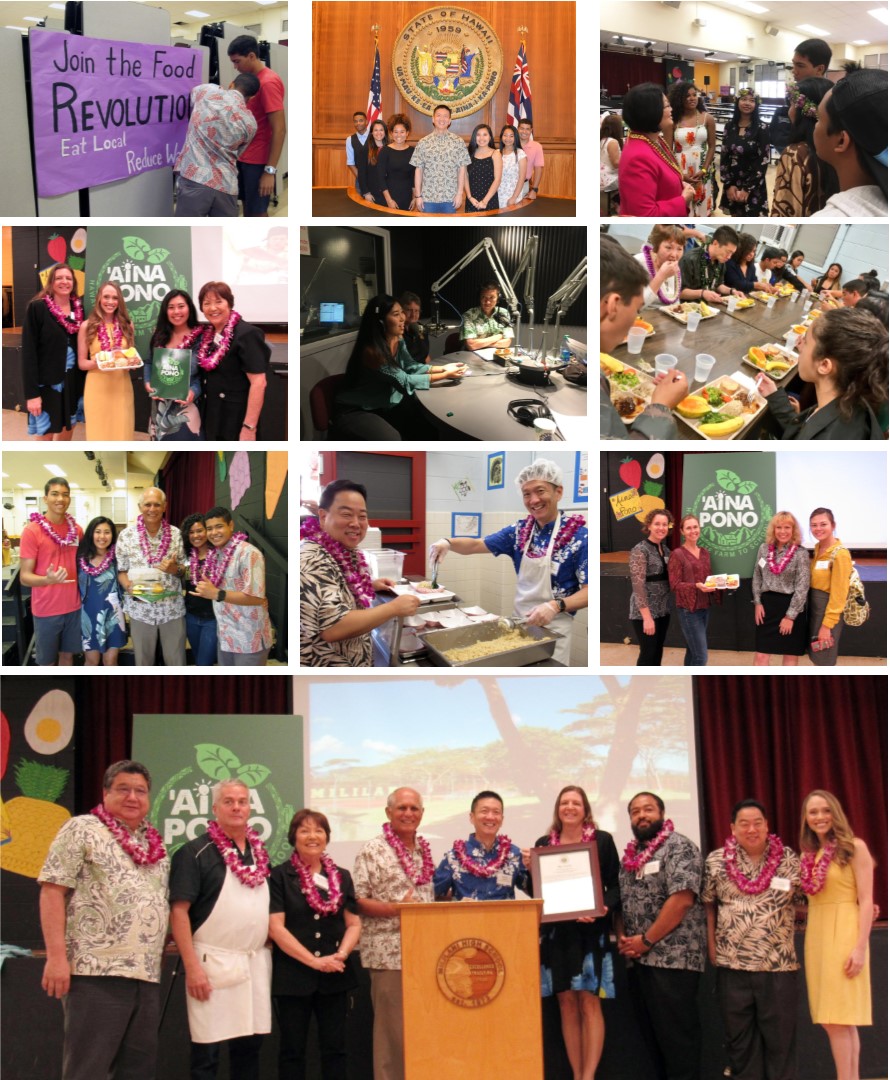
First State-Approved Imu on School Campus
- In celebration of the program’s new name and logo, Mililani High School cooks kalua pork overnight in an imu (underground oven) on its school campus. While some Hawaii schools have organized Thanksgiving fundraising imu events to cook turkeys, this is the first imu-cooked meal to be officially sanctioned and served in a public school cafeteria to students. Lunch also included local pineapples and bananas, spinach, poi, lomi tomato and a freshly baked sweet roll.
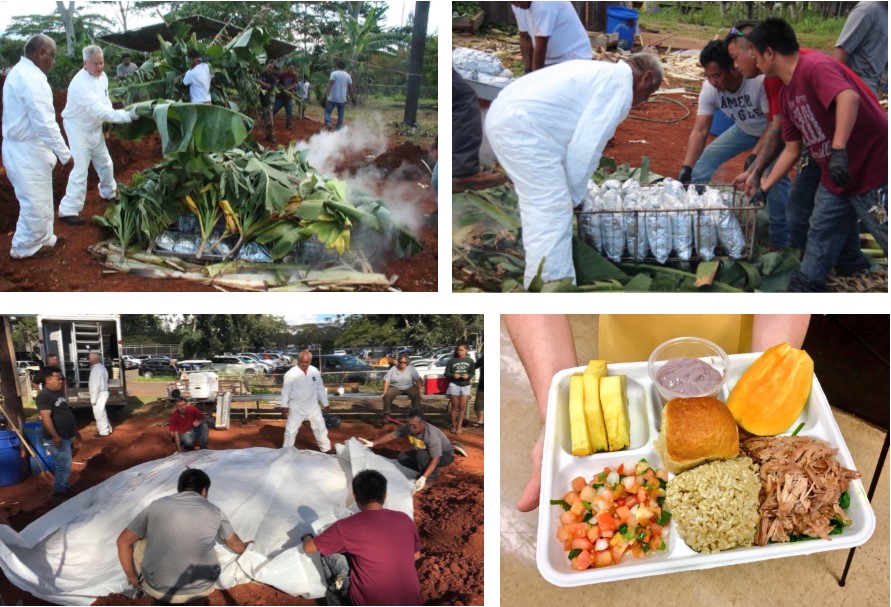
School Garden to Cafeteria Pilot Project
- SFSB launches a School Garden to Cafeteria Pilot Project in partnership with Hawai‘i Farm to School Hui and Kohala Elementary School.
- The Executive Committee selects Anthology Marketing Group to conduct agricultural market research and write a report to help SFSB understand the barriers to local food distributors and producers contracting with SFSB to supply fresh and local produce and meat to schools. Then-Lieutenant Governor Douglas S. Chin hosts ‘Aina Pono Showcase and Sharing event to share results of the Anthology ‘Aina Pono Report and the pilot projects and to connect SFSB with local food producers.
Lessons Learned
SFSB learned a number of important lessons from the pilot projects, including:
- A 3 to 5 percent increase in lunch participation is attainable.
- There is a strong need to incorporate student voice into the development of menus.
- The success of SFSB begins and ends with staff training, and there is a strong need for regular cafeteria staff training. The state employs over 1,200 cafeteria workers in 197 cafeterias feeding 256 schools, as well as charter schools, private schools, senior care centers, and Headstart programs spanning five islands. The training model implemented during the pilot projects entailed a chef consultant, Beyond Green Sustainable Food Partners, providing in depth training for 12+ weeks in a single cafeteria. While this approach was effective, it is ultimately too expensive (~$400,000 per year) and too slow for statewide implementation in 197 cafeterias. Thus, there is a need to develop a comprehensive plan for efficient and cost-effective statewide training.
- It is essential to use a consultant who has exceptional knowledge and experience with the United States Department of Agriculture’s (USDA) requirements in regards to the development of training and creating menus. Since the program receives more than 50 percent of its funding from the USDA, having a consult without such expertise and required skills may lead to the program not receiving funding.
- Overproduction of meals is a severe problem, which may be costing the program financially. During both pilot projects, overproduction decreased significantly. At Mililani High School there was a reduction of 20 percent. At Kohala High School there was a reduction of 10 percent. The decline of overproduction meant a saving in food costs.
- The ability to obtain 30 percent local is more feasible than incorporating 40 percent local in all 256 schools. A target of 30 percent is an increase of 8 to 10 percent over current levels.
- There is a strong need for a data management system for obtaining waste data, cost, local purchases, etc.
- There is a strong need to have both UPW and HGEA a part of the conversation.
- There is a strong need for more staff at SFSB to support the goals of ‘Aina Pono, including additional Registered Dietitians (RD), a Purchase and Supply Specialist, and an Operations Manager.
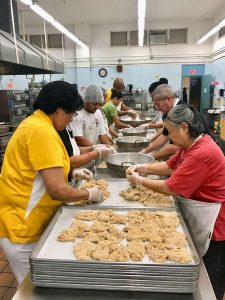
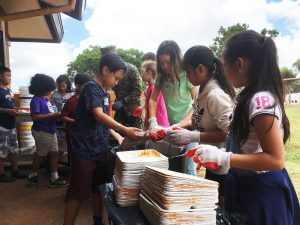
Implementation
During the 2018-19 school year, the Office of the Lt. Governor transitioned leadership of ‘Aina Pono to SFSB. SFSB evolved ‘Aina Pono into a complete values system that includes student health, farm to school, going green, and modernizing systems. Every decision that is made within SFSB reflects the values of ‘Aina Pono, which translates loosely to “good food.” SFSB values its employees, students, farmers, ranchers, and distributors, all of whom help create and deliver good food to Hawai‘i’s keiki and kupuna.
The ‘Aina Pono Executive Committee continues to lead program planning and implementation, factoring in the lessons learned from the pilot schools. The Committee has identified the following key areas for transformation of school food operations to achieve statewide implementation:
- Menu and recipe development
- Staff training
- Procurement
- Data tracking, financial accountability, and waste management
To advance the operational and systems changes required in each of these areas, ‘Aina Pono has undertaken the following during the 2018-19 school year:
- Funding
- Receives $100,000 USDA Farm to School Grant, written by The Kohala Center, to support staff training and program planning
- ‘Aina Pono Harvest
- Continues the ‘Aina Pono Harvest program, featuring:
- 15,000 lbs. of breadfruit – ‘ulu stew (October 2018)
- 12,500 lbs. of local Okinawan sweet potato – sweet potato pie (November 2018)
- 8,000 lbs. of kalo (taro)/poi – kalo yogurt, pineapple parfait (March 2019)
- 10,000 lbs. of green papaya from Hawai‘i ‘Ulu Co-op – chicken papaya soup (April 2019)
- Continues the ‘Aina Pono Harvest program, featuring:

- Procurement
- Brings local beef to cafeterias statewide by entering into contracts to source local beef from Kunoa Cattle Company, Maui Cattle Company, Hawai‘i Beef Producers, and Moloka‘i Livestock Cooperative to provide more than one million pounds of local beef to schools across the state. Total local beef expenditures estimated to equal $5-6 million.
- Advances towards bringing local produce to cafeterias statewide by:
- Spending more than $1 million on local produce through Department of Defense Contracts
- Convening the ‘Aina Pono Local Food Advisory Group with agricultural leaders in Hawai‘i to receive real-time agricultural market information from the industry to inform procurement and menu development
- During the week of October 22, 2018, holding produce procurement meetings on O‘ahu, Hawai‘i Island, Kaua‘i, and Maui with local food distributors and producers to solicit feedback on supplying local produce to HIDOE public schools.
- Awarding contracts to fruits and vegetable companies on Kaua‘i, O‘ahu, and Maui to provide schools with local and nonlocal produce, including green papaya, ripe papaya, apple banana, luau leaves, pineapple, breadfruit and sweet potato.
- Convening Procurement Working Group to:
- develop a multi-term contract produce solicitation for the school year 2019-2020 focused on local fruits and vegetable companies
- initiate a multi-term contract and futures contract for specific local produce items
- Menus and Training
- Shifts statewide menu to 60 fresh, increases local foods on menu, and incorporates some of the most popular pilot recipes into statewide menu. Kohala and Mililani High cafeterias continue to serve pilot menus.
- Retains Chef Cyndie Story, RD, PhD of Culinary Solutions, LLC to assist with standardizing over 200 recipes to facilitate scratch-cooking
- During the week of February 11-15, 2019, holds Weeklong Statewide Culinary Skills Trainings on O‘ahu, Hawai‘i Island, Kaua‘i, Maui, and Moloka‘i, attended by approximately 750 cafeteria staff, approximately 90 of the current workforce. Trainings are conducted by Chef Cyndie Story, RD, PhD, and Chef Kelly Waldrom of Culinary Solutions, LLC, and focus on building the culinary and kitchen management skills needed to scratch-cook meals with fresh, local foods, including knife skills, food preparation, and finding work efficiencies. The training also include waste reduction techniques, taught by Kōkua Hawai‘i Foundation. The Hawai‘i State Department of Health presents on Rat Lung Worm disease at the O‘ahu training.
- Launches online Learning Management System (LMS) to provide on-demand online training for school cafeteria staff
- Creates Menu and Training Task Force with Peter Adler, PhD, Chef Cyndie Story, PhD, Chef Mark Noguchi, Kapiolani Community College, Leeward Community College, and others to develop new protocols for menu development, recipe creation, and training to maximize fresh and local procurement as well as scratch-cooking. The first meeting took place on February 20, 2019. The Task Force is exploring a partnership with the Hawai‘i Community Colleges to develop a School Food Service Manager (SFSM) training program.

- Breakfast
- Launches Breakfast Participation Expansion Initiative with First Lady Dawn Ige and Hawai‘i Child Nutrition Programs to increase breakfast participation at eight pilot schools from 24 to 70.
- Summer Feeding / Homeless Outreach
- Plans summer feeding expansion in O‘ahu’s most severely disadvantaged areas by scheduling the launch of two ‘Aina Pono Food Trucks during summer 2019, in partnership with community organizations
 Public Relations and Communications
Public Relations and Communications
- Retains Blackletter Group to create ‘Aina Pono website and launch marketing campaign to increase breakfast and lunch participation
- IT and Data
- Retains DataHouse to develop new data and financial recordkeeping systems to create greater operational efficiencies, track procurement data, and improve financial accountability and transparency
- Staffing
- Reorganizes School Food Service Branch to include new essential positions to achieve goals
- Redesigns School Food Service Branch office to accommodate future staff
- Waste Tracking
- Continues to partner with Kōkua Hawai‘i Foundation to track cafeteria waste.
- School Gardens
- Continues to partner with Hawai‘i Farm to School Hui and HIDOE’s Office of Curriculum & Instructional Design to advance school gardens and the School Garden to Cafeteria Pilot Project.
- New Modernization System
- Development of Request for Proposal (RFP) for a new modernization system
- Identify severely needed cafeterias which need modernization. The ability to accomplish 60 percent scratch cooking and no more than 40 percent process foods requires cafeterias be correctly equipped with updated technology, an inventory management system and the necessary equipment.


